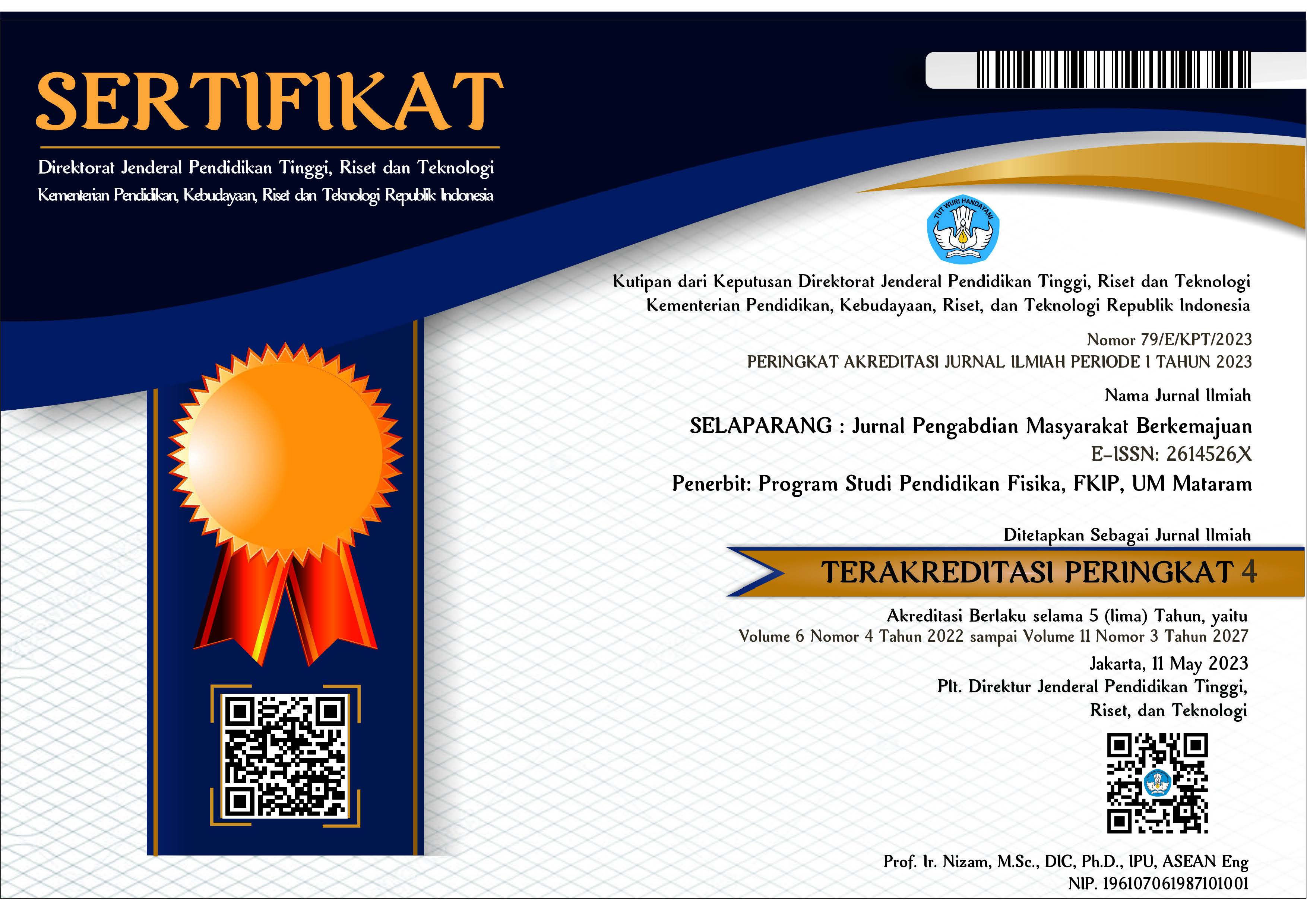SIMULASI APLIKASI INTERAKTIF PHET BAGI SISWA SMA PLUS NUSA TIMOR
Abstract
ABSTRAK
Perkembangan teknologi informasi yang pesat mengubah pola kehidupan pada berbagai aspek. Wujud perkembangannya bisa dilihat pada aspek pendidikan diantaranya pelaksanaan belajar secara online dan evaluasi belajar secara online. Dampak lain dari perubahan tersebut yakni kecenderungan siswa menggunakan media belajar yang disukai, mudah diakses, serta tertarik pada media-media belajar yang interaktif. Pergeseran pola belajar siswa yang demikian menuntut guru untuk mencari serta membiasakan diri untuk menggunakan media belajar interaktif sesuai kebutuhan belajar. Media simulasi interaktif PhET adalah salah satu cara guru menghadirkan pembelajaran interaktif di tengah pembelajaran. Tujuan kegiatan yakni menjaring informasi siswa tentang pembelajaran menggunakan aplikasi simulasi PhET. Topik simulasi dalam kegiatan mencakup kesetimbangan benda, hukum Hooke serta gaya dan gerak benda. Metode yang digunakan dalam kegiatan ini adalah metode simulasi. Evaluasi kegiatan menggunakan angket respon pembelajaran dengan simulasi PhET. Hasilnya menunjukkan 88% siswa puas terhadap pembelajaran interaktif dengan media PhET. Selanjutnya penggunaan aplikasi interaktif ini diharapkan mampu membangun konsep-konsep fisika dan keterampilan proses sains siswa.
Kata kunci: pembelajaran interaktif; simulasi PhET; hasil belajar.
ABSTRACT
The rapid development of information technology changes the pattern of life in various aspects. The form of its development can be seen in the educational aspects including online learning implementation and online learning evaluation. Another impact of this change is the tendency of students to use learning media that they like, are easily accessible, and are interested in interactive learning media. This shift in student learning patterns requires teachers to seek out and get used to using interactive learning media according to learning needs. PhET interactive simulation media is one way for teachers to present interactive learning in the middle of learning. The purpose of the activity is to collect student information about learning using the PhET simulation application. Simulation topics in activities include the equilibrium of objects, Hooke's law and the forces and motion of objects. The method used in this activity is the simulation method. Evaluation of activities using a learning response questionnaire with a PhET simulation. The results showed that 88% of students were satisfied with interactive learning using PhET media. Furthermore, the use of this interactive application is expected to be able to build students' physics concepts and science process skills.
Keywords: interactive learning; PhET simulation; learning outcomes.
Keywords
Full Text:
PDFReferences
Anitasari, B., Winarti, A., & Rusmansyah, R. (2019). MEDIA SIMULASI PhET (PHYSICS EDUCATION TECHNOLOGY) UNTUK MEREDUKSI MISKONSEPSI SISWA PADA KONSEP ASAM BASA. Quantum: Jurnal Inovasi Pendidikan Sains, 10(1), 8. https://doi.org/10.20527/quantum.v10i1.5713
Jerusalem, E. (2019). Children, technology and teaching. 55–80.
Miftah, M. (2013). Fungsi, Dan Peran Media Pembelajaran Sebagai Upaya Peningkatan Kemampuan Belajar Siswa. Jurnal Kwangsan, 1(2), 95. https://doi.org/10.31800/jurnalkwangsan.v1i2.7
NAEYC. (2012). Technology and Interactive Media as Tools in Early Childhood Programs Serving Children from Birth through Age 8. Children, January, 1–15. http://www.naeyc.org/positionstatements
Raja, R., & Nagasubramani, P. C. (2018). Impact of modern technology in education. Journal of Applied and Advanced Research, 3(S1), 33. https://doi.org/10.21839/jaar.2018.v3is1.165
Rizaldi, D. R., Jufri, A. W., & Jamal. (2020). PhET : SIMULASI INTERAKTIF DALAM PROSES PEMBELAJARAN FISIKA. Jurnal Ilmiah Profesi Pendidikan, 5(1), 10–14. https://doi.org/10.29303/jipp.v5i1.103
Saputra, R., Susilawati, S., & Verawati, N. N. S. P. (2020). Pengaruh Penggunaan Media Simulasi Phet (Physics Education Technology) Terhadap Hasil Belajar Fisika. Jurnal Pijar Mipa, 15(2), 110. https://doi.org/10.29303/jpm.v15i2.1459
Uştu, H. (2014). No 主観的健康感を中心とした在宅高齢者における 健康関連指標に関する共分散構造分析Title. https://doi.org/10.1038/132817a0
Wang, L. N. (2011). Impact of information technology on accounting. Advanced Materials Research, 219–220(131), 1224–1227.
https://doi.org/10.4028/www.scientific.net/AMR.219-220.1224
Wieman, C. E., Adams, W. K., Loeblein, P., & Perkins, K. K. (2010). Teaching Physics Using PhET Simulations. The Physics Teacher, 48(4), 225–227. https://doi.org/10.1119/1.3361987
Wieman, Carl E., Adams, W. K., & Perkins, K. K. (2008). Physics. PhET: Simulations that enhance learning. Science, 322(5902), 682–683. https://doi.org/10.1126/science.1161948
DOI: https://doi.org/10.31764/jpmb.v4i1.3286
Refbacks
- There are currently no refbacks.

This work is licensed under a Creative Commons Attribution-ShareAlike 4.0 International License.
______________________________________________________
Jurnal Selaparang
p-ISSN 2614-5251 || e-ISSN 2614-526X
EDITORIAL OFFICE:



















